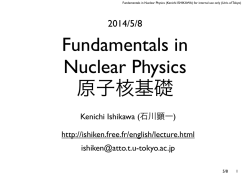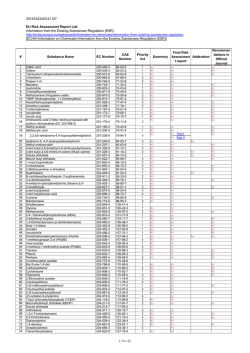
Material / 講義資料 - 石川顕一
Fundamentals in Nuclear Physics (Kenichi ISHIKAWA) for internal use only (Univ. of Tokyo) 2014/5/22 Fundamentals in Nuclear Physics 原子核基礎 Kenichi Ishikawa (石川顕一) http://ishiken.free.fr/english/lecture.html [email protected] 2014.5/22 1 Fundamentals in Nuclear Physics (Kenichi ISHIKAWA) for internal use only (Univ. of Tokyo) Nuclear reactions (2) 2014/5/22 2 Fundamentals in Nuclear Physics (Kenichi ISHIKAWA) for internal use only (Univ. of Tokyo) Resonance 4 10 3 (n,t) 1/v law 2 10 162 共鳴 resonance 1 10 3. Nuclear reactions 0 10 -1 10 (n,p) -3 10 -4 10 -5 10 -3 -1 10 10 1 3 10 10 Energy (eV) 5 10 3.1 Cross-sections 7 10 117 10 E (MeV) 7.459 6.668 −2 −4 (n,fission) (/105 ) 238 2 U elastic 1 −2 3 H 4 He 7 Li Fig. 3.5. The energy levels of 7 Li and two dissociated states n −6 Li and 3 H − 4 He. 6 (n,γ) (/100) 10 10 0 U 10 4.630 0.477 2 10 10 n 6 Li 235 1 (n,gamma) -2 10 複雑なエネルギー依存性 elastic (x10) (n,n) 10 重い核には多くの励起状態 Many excited states for heavy nuclei complicated resonance structure JENDL cross−section (barn) Cross section (barn) 10 6Li 共鳴 −4 1 (n ,γ) (/10 4 ) 10 10 2 Excited states of 239U E (eV) 10 3 2014/5/22 Fig. 3.26. The elastic and inelastic neutron cross-sections on 235 U (top) and 238 U (bottom). The peaks correspond to excited states of 236 U and 239 U. The excited 3 Fundamentals in Nuclear Physics (Kenichi ISHIKAWA) for internal use only (Univ. of Tokyo) Resonance line shape Resonance (E) A E0 )2 + ( /2)2 (E 2.0 1.5 full width at half maximum (FWHM) 半値全幅 Doppler effect 1.0 1.0 ドップラー効果 0.8 long tail 0.5 0.6 0.4 -3 -2 -1 1 2 Lorentzian ローレンツ関数 E3 0.2 -3 Life time Decay rate · = : 自然幅 natural width = / homogeneous width uncertainty principle = / 1 不確定性原理 -2 -1 1 2 3 ドップラー幅 inhomogeneous width (E E0 )2 exp E2 2014/5/22 4 Fundamentals in Nuclear Physics (Kenichi ISHIKAWA) for internal use only (Univ. of Tokyo) Time-dependent wave function of an excited state (r, t) = (r)e 2 2 | (r, t)| = | (r)| iE0 t/ does not decay To be consistent with the exponential decay law 2 2 | (r, t)| = | (r)| e t/ (r, t) = (r)e iE0 t/ e t/2 Energy spectrum (by Fourier transform) 2 P (E) eiEt/ e iE0 t/ e t/2 dt 0 1 (E E0 )2 + ( /2)2 2014/5/22 5 核子-原子核散乱の量子力学的取り扱い Quantum treatment of nucleon-nucleus scattering 4 10 JENDL 3 Cross section (barn) 10 2 10 1H(n,n) 1 10 2H(n,n) 6Li(n,n) 0 10 -1 10 -5 10 -3 10 -1 10 1 3 10 10 Energy (eV) 5 10 7 10 2014/5/22 6 Fundamentals in Nuclear Physics (Kenichi ISHIKAWA) for internal use only (Univ. of Tokyo) isotropic scattering V(r) R angular momentum 角運動量 1.2A1/3 fm R 等方散乱 r L = kR kR 1 for neutron scattering 中性子散乱 ( c)2 2mn c2 R2 p2 E= 2mn V0 Schrödinger equation eikr r z eikz 2 2m k (r) 2 シュレーディンガー方程式 + V (r) = eikz 13 MeV A2/3 f eikr + r 2 2 k k (r) = 2m k (r) (r > R) 2014/5/22 7 Fundamentals in Nuclear Physics (Kenichi ISHIKAWA) for internal use only (Univ. of Tokyo) eikz = (2l + 1)il jl (kr)Pl (cos ) l=0 10.48 spherical Bessel function Legendre polynomial 球ベッセル関数 ルジャンドル多項式 Graphs 263 P0 (cos ) = 1 P1 (cos ) = cos 3 P2 (cos ) = cos2 2 Figure 10.48.1: jn (x), n =l 0(1)4, 0 x 12. jl (kr) (kr) /(2l + 1)!! 118 1 2 Figure 10.48.2: yn (x), n = 0(1)4, 0 < x 12. 3. Nuclear reactions 5 800 MeV (x50) 5 5 2 5 2 5 dσ /dcos θ (barn) sin z j0 (z) = z sin z cos z j1 (z) = 2 p z + y (x), 0 x 12. Figure 10.48.3:zj (x), y (x), j (x) 1H 1MeV 100MeV (x20) 0 5 0.1 MeV 9Be 1 MeV 10 MeV 0 Figure 10.48.4: j05 (x), y50 (x), 5 12. q j05 2 (x) + y50 2 (x), 0 x 0.1 MeV 208Pb 1 MeV (x0.5) 0 −1 10 MeV (x0.2) cosθ 1 Fig. 3.6. The differential cross-section, dσ/d cos θ = 2πdσ/dΩ, for elastic scattering of neutrons on 1 H, 9 Be and 208 Pb at incident neutron energies as indicated [30]. At low incident momenta, p < ¯ h/Rnucleus , the scattering is isotropic whereas for 2014/5/22 8 Fundamentals in Nuclear Physics (Kenichi ISHIKAWA) for internal use only (Univ. of Tokyo) k (r) = sin kr e kr anisotropic ikz + sin kr f eikr + kr r isotropic 等方 非等方 sin kr f eikr + kr r isotropic k (r) uk (r) = r (r > R) near the boundary kR 1 ポテンシャルの境界近く isotropic also at r < R ポテンシャル内でも等方 k (r) 2 2 2 k d2 uk + V (r) uk (r) = uk (r) 2 2m dr 2m uk (r) = sin kr + f eikr k (r > R) 2014/5/22 9 Fundamentals in Nuclear Physics (Kenichi ISHIKAWA) for internal use only (Univ. of Tokyo) Solution at r < R uk (r) = A sin Kr (r < R) Boundary condition uk(r) and uk’(r) continuous at r = R 境界条件 kR f =R 1 tan KR KR 1 2mV0 K 2 low-energy scattering Cross section = 4 |f |2 = 4 R2 Scattering length a= tan KR KR 2 1 散乱長 f (k = 0) (k 0) = 4 a2 2014/5/22 10 Fundamentals in Nuclear Physics (Kenichi ISHIKAWA) for internal use only (Univ. of Tokyo) = 4 |f |2 = 4 R2 tan KR KR 2 1 R2 30 25 20 15 10 5 1 2 3 4 5 6 KR R 2mV0 2 ~ depth of attractive potential kR = /2 infinite scattering length R2 no scattering “Ramsauer-Townsend effect” ラムザウアー・タウンゼント効果 2014/5/22 11 Fundamentals in Nuclear Physics (Kenichi ISHIKAWA) for internal use only (Univ. of Tokyo) Nucleon-nucleon effect 核子-核子散乱 4 10 flat region 20 b el JENDL 3 Cross section (barn) 10 range of the strong interaction (2fm)2 0.1 b 2 10 1H(n,n) kR 1 10 6Li(n,n) 0 -5 10 -3 10 -1 10 1 3 10 10 Energy (eV) 5 10 7 10 |u| 2 33 deutron u(r) = sin kr -1 10 V0R2~109 MeV fm2 1.4 Nuclear forces and interactions 2H(n,n) 10 /2 u(r) = exp(−κ r) 重陽子 r=R V(r) V(r)=−V0 V(r)=0 r Fig. 1.10. A square-well potential and the square of the wavefunction ψ(r) = u(r)/r. The depth and width of the well are chosen to reproduce the binding energy and radius of the deuteron. Note that the wavefunction extends far beyond the effective range of the s = 1 nucleon–nucleon potential. 2014/5/22 12 the deuteron is bound. For the s = 0 system, V0 R is slightly less than Fundamentals in Nuclear Physics (Kenichi ISHIKAWA) for internal use only (Univ. of Tokyo) 109 MeV fm2 so there is no bound state. In the scattering problem considered here, the quarter wavelength leads to a scattering cross-section that is much larger than 4πR2 since the tangent in (3.197) is large. Nucleon-nucleon effect Table 3.3. The low-energy nucleon–nucleon scattering amplitudes and effective ranges taken from the compilation [34]. The last two columns give the potential parameters derived from the deuteron binding energy and the scattering formula (3.197). Note that f ≫ R for the s = 0 amplitudes. 核子-核子散乱 f (fm) R (fm) V0 (MeV) V0 R 2 (MeV fm2 ) n–p (s=1, T=0) +5.423 ± 0.005 1.73 ± 0.02 46.7 139.6 n–p (s=0, T=1) −23.715 ± 0.015 2.73 ± 0.03 12.55 93.5 p–p (s=0, T=1) −17.1 ± 0.2 2.794 ± 0.015 11.6 90.5 n–n (s=0, T=1) −16.6 ± 0.6 2.84 ± 0.03 11.1 89.5 The cross-section for 3the scattering neutrons on unpolar1on unpolarized 2 2 = 4 |f | + 4 |f | 20 p s=1 s=0 ized protons is thenweighted in theb(s = 0) and (s = 1) 4 sum of the cross-section 4 state. Since there are three spin-aligned states and only one anti-aligned state we have σn−p = (3/4)4π|fs=1 |2 + (1/4)4π|fs=0 |2 = 20.47 b . (3.199) This corresponds to the low-energy limit of the neutron–proton cross-section2014/5/22 13
© Copyright 2026

